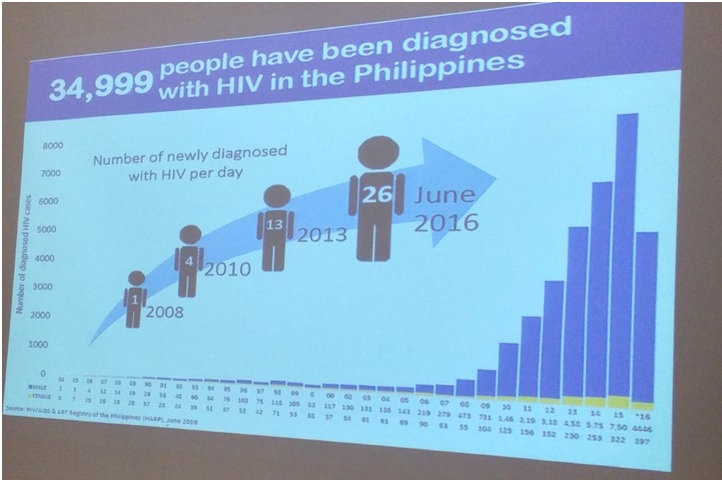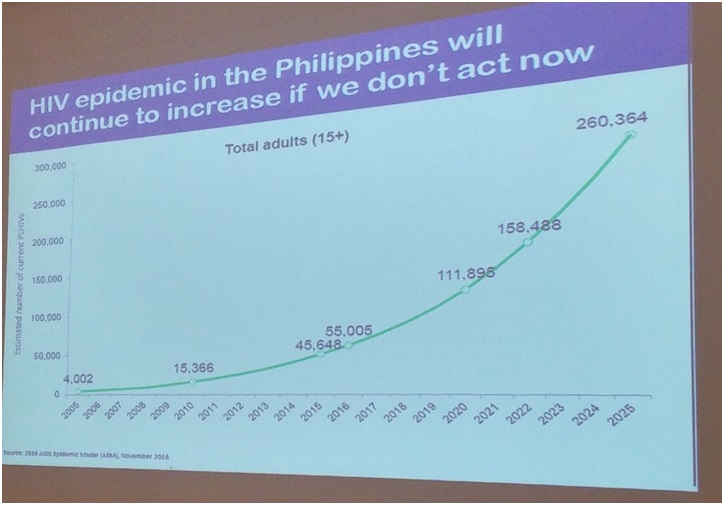This is where we stand as we mark World AIDS Day today: The Philippines is now one of seven countries burdened with an alarming increase in the rate of HIV/AIDS infection.
From a “low and slow” prevalence rate in the early 2000s, the rate of infection is now “fast and furious,” with 26 new HIV cases reported daily. Given the stigma attached to this pandemic, it is safe to assume that the number of unreported cases could be much more.
In fact, according to the Department of Health’s HIV/AIDS and ART (anti-retroviral therapy) Registry of the Philippines (HARP), from January 1984 (when the first HIV case in the country was reported) to June 2016, a total of 34,999 cases were reported, most of them asymptomatic.
ADVERTISEMENT
The biggest number of reported cases are from the National Capital Region, with Calabarzon a close second. Sexual contact remains the most common mode of transmission, followed by injecting drug use. Of infections transmitted through sexual contact, 89 percent are among males who have sex with males (MSM).
Particularly worrisome is that the cases have been getting younger through the years. Between 2001 and 2005, the age group with the biggest proportion of cases was 35-49 years; from 2006, it has become 25-34. The proportion of HIV cases in the 15-24 age group increased from 25 percent in 2006-2010, to 28 percent in 2011-2016. In this last group, 94 percent were male, with 96 percent of them infected through sexual contact. That most of the cases involved MSM isn’t surprising; at that age, most males are adventurous and reckless.
It’s a risk and reality that could have been addressed with sex education in schools where young people make for a captive audience, had the Supreme Court not blocked the full implementation of the Reproductive Health Law. Among the issues that could have been addressed by age-appropriate sex education as provided for by the RH Law is safe sex, as well as the ABCD of HIV/AIDS prevention: abstinence, being faithful, condom use, drug use prevention, and so on. These are basic information that the young, who feel invincible, are not likely to seek out on their own.
The Catholic Church shares the responsibility for abetting the HIV/AIDS crisis, with its continued condemnation of condom use—because, as its bishops have said repeatedly, the prophylactic might be used by couples as a contraceptive device.
It has now been left largely to private groups and NGOs to keep the virus at bay with continuing education, information campaigns and peer counseling, while the DOH and its satellite treatment centers offer free anti-retroviral drugs and free HIV/AIDS testing that—it can’t be stressed enough—is crucial to detect the infection early and tame it with proper treatment.
Fortunately, at an earlier press briefing, the private sector launched an initiative that could help HIV patients comply with their treatment regimen, failure of which could lead to the virus becoming drug-resistant. Called “Connect for Life,” the texted reminder system launched by the SHIP Clinic, Johnson & Johnson and other partners, addresses major challenges in managing HIV/AIDS, including the Philippines’ diverse geography that limits patients’ access to healthcare services. There are also the lingering stigma and sense of shame that make AIDS patients withdraw instead of reaching out to their doctors more often.
Patients can register with SHIP or call J&J, and choose how they want to be reminded or contacted for timely health and fitness tips, consultation, medical advice, and other services they may need in managing the virus. Doctors for their part get a more accurate and updated clinical information system to further engage with their patients. Offered free to HIV patients, the service maintains privacy and confidentiality between patient and health provider through a PIN number that allows only the patient to see the messages. Best of all, the medium used—the mobile phone—is most appropriate, being the ubiquitous device of this age.
It’s community efforts like these that make the HIV+ feel more positive about the future.
Philippine Daily Inquirer / 12:28 AM December 01, 2016
Read more: http://opinion.inquirer.net/99661/26-new-hiv-cases-daily#ixzz4S7VPZkd0



